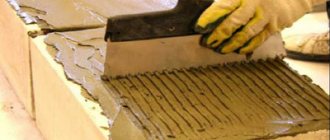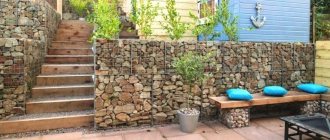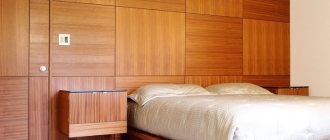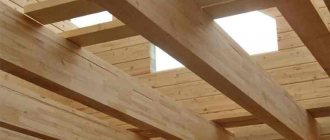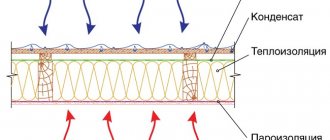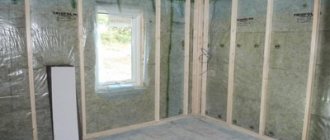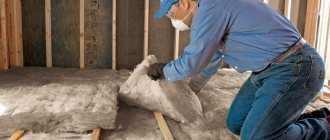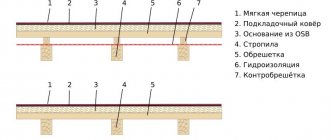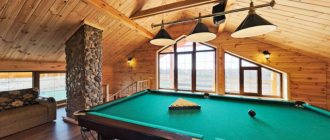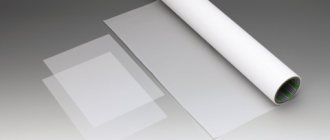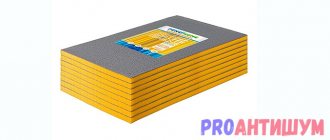Materials used in the construction of roofs and arrangement of premises with non-standard temperature and humidity operating conditions are endowed by manufacturers with special properties. They not only easily resist the attacks of steam-saturated hot air, but also create a “thermos” effect, due to which energy consumption for heating is greatly reduced.
These specific products include foil vapor barrier, the installation of which allows you to solve a lot of important problems in the construction of building structures.
Application area
The described materials are used as a vapor barrier in rooms with high humidity, such as baths and saunas. The film does not melt, does not release substances hazardous to human health into the air, and can be used at temperatures up to +120 °C.
When installing modern steam rooms, the reflective properties of foil vapor barrier are very important, because the sauna should warm up in a short time after heating the stove, and energy costs should be reduced. However, foil vapor barrier is used today not only in the bathhouse.
When building a frame house, conventional vapor barriers are increasingly being replaced with foil ones. With the same heating power, using this approach it is possible to increase the room temperature by 2 °C. However, such material must be used wisely, because it should not be used for internal thermal insulation of buildings made of concrete and brick, as well as other heat-intensive materials.
What kind of material is this?
Foil insulation is a roll of insulation consisting of 2-3 layers . The first layer is the base, the main material that performs a thermal insulation function. The second layer is foil glued to the base, reflecting heat into the room and protecting the base layer from external influences.
The third layer is a self-adhesive base covered with a protective film. This layer is not always present in insulation materials; if it is not present, then additional special glue is purchased for installation.
How does it work?
Due to the reflective effect, the foil returns the heat generated from any source .
In other words, foil insulation only works if there is an open source of heat in the house. This could be a UV heater, stove heating, or fireplace. The heated air will not escape into the walls, floor and roof to the street; the foil retains the heat indoors.
It also has waterproofing properties. If you lay a layer of foil insulation under the floor with the foil facing the wood, the wood will stop accumulating moisture from the ground. This way, floor joists and boards will not rot for many years to come.
Recommendations for use
If the walls are frozen, this will worsen the microclimate. As for a wooden house made of timber or logs, foil vapor barrier is ideal for internal insulation. It can also be used for unheated loggias, laying it under the finishing floor covering to make it warmer. When glazing open balconies, when the perimeter is supposed to be finished with sandwich panels that do not emit heat, foil vapor barrier allows you to reduce heating costs.
Types of foil vapor barrier
Foil vapor barrier is offered for sale today in a wide range. In order for the material to perform its functions, it is important to make the right choice. It is necessary to pay attention to the fact that the polymers included in the substrate may have different structures. They consist of polypropylene foam and polyethylene foam. For more impressive temperatures, the first option should be used, while the second is relevant for a less aggressive environment.
Foil vapor barrier for baths is presented in the “Penotherm” variety. In this case we are talking about a material that includes foamed propylene foam. The material can be used at temperatures ranging from -40 to +150 °C. Vapor barrier is characterized by a low-hazard toxicity class and moderate flammability. There is almost no thermal shrinkage during use.
If you want to install a heated floor system, you should prefer NPPLE. This variety can also be used for a steam room. Foil vapor barrier "Izospan FB" is designed to form a vapor barrier in saunas and baths. The material can be used at fairly high temperatures. That is why the Izospan vapor barrier plus foil insulation is excellent for particularly difficult conditions.
How to attach a vapor barrier
The choice of fastening method depends on the type of vapor barrier material used. Polyethylene and polypropylene films are secured with small nails or with staples and a construction stapler.
Construction stapler (mechanical)
In order to minimize damage, it is advisable to use wooden planks that press the film against the guides, and drive staples/nails into the plank. Membranes can be attached in the same way. They are not as torn as films made of polyethylene or polypropylene, and they are easier to work with.
Attaching the vapor barrier
The sheets of rolled materials are laid one on top of the other with an overlap of at least 10-15 cm, gluing the joints with adhesive tape. You can use specialized, foil or regular adhesive tape.
Double-sided adhesive tape UNIBOB based on cotton fabric. An adhesive layer based on synthetic rubber, which ensures high quality gluing of vapor-waterproofing sheets
Foil tape must be used at the joints of foil materials, otherwise most of their effectiveness is lost. When gluing joints of other materials, manufacturers recommend using their own adhesive tape, but they do not explain their differences and advantages.
Please note that during installation the vapor barrier sheets should not be stretched: they tend to stretch/shrink when temperatures change. To avoid ruptures during tension, you need to leave a small margin. It is considered normal for the canvas to “sag” by 1-2 cm during installation. This is especially true when laying a vapor barrier on a roof or in an unheated room.
When installing vapor barriers in places with complex terrain (protrusions, corners, etc.), it is advisable to seal the adjacent surfaces with tape: perfect tightness in such places is difficult to achieve, and this is the main condition for the effectiveness of protection. Therefore, any aids will be useful. It is also necessary to tape the edges of the vapor barrier around the perimeter of door and window openings to ensure a tight seal. In general, tightness is the basis for high-quality vapor barrier of a bathhouse, roof or any other room. Therefore, when carrying out work, pay maximum attention to this aspect.
Features of "Alufoma" and "Tepofol"
The polyethylene foam base is “Alufom”, which has a one-sided coating of aluminum foil. The operating temperature ranges from -60 to +100 °C. Vapor barrier performs the functions of sound, hydro, steam and heat insulation, and also reliably protects against radon. It can be used for thermal insulation of roofs and floors. The wrinkled texture allows you to bend around curved elements of small radii without tearing the coating.
Foamed polyethylene is the basis of Tepofol, which in different variations has a reflective layer on one or both sides. The temperature effect can vary from -60 to +100 °C. This vapor barrier can be used for thermal insulation of air ducts, roofs and walls, as well as for the installation of heated floors.
Foil vapor barrier for a home must be completely safe, such as Izolon, which is environmentally friendly. The base is foamed polyethylene foam. The vapor barrier is vapor-tight, durable, and is distinguished by the flexibility and softness of the foil layer.
When to use foil insulation for the ceiling
Insulation with a reflective layer is used for thermal insulation of walls and ceilings in houses and apartments. They are suitable for commercial and residential premises. Most often, penofol and isolon are used for insulating loggias and balconies.
Independent use of polyethylene foam insulation with foil is permissible on the ceiling of a room above which there is a warm attic or attic. Due to their increased moisture resistance, these insulators are used to insulate the ceilings of kitchens, baths, bathrooms, and saunas.
How to properly and how to insulate a ceiling in a wooden house with a cold roof
Important! When insulating the ceiling of a living room under an unheated room, reflective thermal insulation is used in complex insulation with other materials.
Features of "Penofol", foil vapor barrier for the attic
If you need a foil vapor barrier for the attic, then you may prefer Penofol, which is based on a material with a thickness ranging from 0.2 to 1 cm. The thickness of the foil is 20 microns. It is also important to take into account the reflection coefficient, it is equal to 97%.
On sale you can find material for use in harsh climates, in this case the thickness of the main layer will be 40 mm. The foil layer also creates a barrier to heat transfer due to foamed polyethylene, which has a huge number of pores filled with carbon dioxide and air. Penofol can be used independently or in combination with other thermal insulation materials. It is especially useful if it is necessary to insulate the surface and not lose the usable area of the room.
Installation technology
Most often, vapor barrier materials with foil are used to equip a cold attic and a warm attic. In the first case, the insulation system must be installed along the ceiling, in the second - along the slopes.
To install a vapor barrier correctly , you need to adhere to generally accepted construction rules:
- The vapor barrier of the slopes should be a continuous barrier that prevents the penetration of moisture. To do this, the canvases need to be sealed together with regular tape.
- Strips of vapor barrier material are usually laid strictly horizontally. The first panel is fixed at the ridge girder, the second is placed on top to cover the edge of the installed panel on the side of the room that is being finished.
- The canvas spreads from the attic side onto the wooden floor in strips, extending onto the walls along with vertical ceilings of 20 cm each. It turns out to be a kind of pallet with sides.
- Then the material is rolled out as if the roll was formed by the manufacturer himself. The installation side is indicated on the vapor barrier - it cannot be changed at your discretion.
- On pitched roofs, the material is stapled to the rafters from the inside. If they are fixed with a block, then a counter-lattice must be placed on top under further cladding.
- If you need to put a vapor barrier in a system with open rafters, then it is placed along the outer ribs, then rigid slab insulation is installed. The fabric is secured with a stapler.
- If you are installing a ceiling on the ceiling side, then you need to buy self-adhesive materials.
It is worth noting that accessories for foil insulation must be selected from the same manufacturer as the material. Of course, you can find universal tape on sale that is suitable for joining materials of any kind, but in the case of foil structures, you need to remember about tightness. Therefore, here it is better not to experiment with options for adhesive tape for gluing, but to take it from the same company that produces the foil sheets themselves.
Additional solution for the attic: “Ondutis R Termo”
This material is used for thermal insulation of metal and wooden structures. When insulating an attic space or installing a roof in a residential attic, the film allows you to retain heat and reduce heating costs.
The water resistance of this vapor barrier is 1000 mm of water column; as for the minimum vapor permeability, this parameter is less than 10 g/m2 per day. The material easily endures temperature changes ranging from -40 to +120 °C. When considering strength, you should pay attention to the breaking load, which is 150 N along and 130 N across. This indicates that this foil film can support the weight of an adult.
Dew point problem
Ideally, the roof in the attic should be insulated from the outside at the stage of forming the roofing pie. However, often this is done the other way around from the inside, when the house is already covered with a roof. And here certain problems arise.
The correct and ideal roofing pie is several layers of different materials laid on top of the rafters tightly on top of each other without gaps. Such a sandwich ensures that the dew point will be located on its outer side. As a result, all condensate formed outside will quickly evaporate into the atmosphere.
By doing insulation from the inside, after installing the roof, it is impossible to form the exemplary roofing pie described above. It will not be possible to press the insulation onto the roof so that there are no voids left between them.
But steam always moves towards cold air. And then, each of the formed cavities will begin to accumulate condensation and moisture. And this is a direct path to damage to the thermal insulation material and wooden elements of the rafter system.
When insulating an attic internally, the dew point has to be shifted into the space between the laid roof and the insulation, leaving an additional 5–10 cm gap there for ventilation. Only such a technology and such a cake will avoid moisture in the insulating material.
To reduce the amount of water vapor in the insulation, its installation should be done using a vapor barrier film. A vapor barrier is installed from the inside of the attic on top of the thermal insulation material.
The steam must first encounter this film and mostly remain in the room. The less of it gets into the insulation layer, the better.
The main advantages of Penofol
Before purchasing Penofol, it is important to pay attention to its advantages, among them the following should be highlighted:
- high environmental friendliness;
- low vapor permeability;
- ease of installation;
- ease of transportation;
- insignificant thickness;
- noise absorption ability;
- high fire safety;
- inaccessibility for rodents.
The main disadvantages of Penofol
Some consumers refuse to purchase Penofol when they learn about its shortcomings. Among them:
- high penetration;
- inconvenience during installation due to the need to use special adhesives;
- Insulating walls from the outside with Penofol involves using the material only as an additional layer of thermal insulation.
As for high penetration, it will manifest itself even at low pressure; this characteristic is due to the softness of the material.
Choosing the best vapor barrier for the roof
- single-layer film - most often this is a simple polyethylene film, the cheapest and most unreliable material. This is not the most durable material on the market.
- reinforced - a stronger material due to the reinforcing middle layer - reinforced mesh. The top of this mesh was covered with polyethylene. This double-sided lamination ensures vapor permeability.
- universal - it is unique in that it is suitable for all structures and works with all types of insulation.
- unreinforced membrane is a multilayer material with high insulating properties, thanks to the foil layer, which copes with its functions perfectly.
Types of foil vapor barrier in the form of film
Foil vapor barrier for walls can be represented by film. It is able to protect the insulation from moisture that penetrates from the premises. If you use such a vapor barrier in a bathhouse, then the inner lining can be reliably protected from rot and mold that appear due to condensation after the steam room is turned off.
Such a foil reflective vapor barrier will reflect heat, and condensation simply will not settle. The film can be made from kraft paper; this option is inexpensive, easy to handle, hygroscopic, and quite easy to tear.
Vapor barrier can also be made on a polymer basis, in this case it is durable and strong, but will cost more. If there is aluminum coating on the surface, then the thickness will start from 0.3 microns, however, as the thickness of the coating decreases, the heat-reflecting abilities will deteriorate.
Foil vapor barrier for frame walls can have a base made of aluminum foil. In this case, the thickness of this layer will start from 10 microns, which will guarantee the maximum level of reflection. Such materials are susceptible to corrosion and therefore require additional protection. Experts advise insulating the walls of rooms with high humidity using aluminum-coated polymer-based foil films, since they do not corrode and can withstand high temperatures. They are durable, which greatly simplifies installation.
Films based on kraft paper can only be used in dry rooms; they cannot be used in bathrooms or kitchens. For heated floors, it is recommended to purchase a film with aluminum foil, which distributes heat, smoothing out cold bridges if the pipes are not laid tightly enough.
Principle of operation
Foil materials are a complex product with a layered structure. The base here is polypropylene fabric, fiberglass, and lavsan. These are components that are resistant to explosive effects, biological and chemical aggression.
The use of a durable non-woven or woven polymer base allows you to create a reliable base for metal foil, which itself cannot boast of particular strength. At the same time, flexibility convenient for installation is maintained. This composition eliminates the possibility of fungal colonies settling and rotting.
Vapor barrier materials on the working side are backed with metallized film. The positive qualities of both aluminum foil and the polymer base are preserved. Vapor barrier with foil copes with three tasks at once:
- Insulation from precipitation and steam. The foil material protects the wall insulation system or roofing pie from steam penetration.
- Reflection of thermal radiation. The metal coating serves as a kind of reflector; it interrupts the flow of heat waves, redirecting the stopped heat within the house.
- Protection from ultraviolet rays and wind. Vapor barrier films are a durable barrier against wind. In the summer, they are able to reflect the sun's rays from the roof if they are installed with the working side facing outwards.
Varieties of "Penofol"
"Penofol" can be classified by type:
- A.
- IN.
- WITH.
- ALP.
- R and M.
- Super NET.
- AIR.
In the first type, the aluminum layer is applied only from the outside; this material is used in conjunction with polystyrene foam and styrodur. Type B is coated on both sides and is suitable for independent use. Type C is a self-adhesive material in which the outside is covered with foil, while the inside is polyethylene foam with contact adhesive.
ALP is “Penofol”, on top of the aluminum layer of which a polyethylene film is fixed. This material is laminated and can be used for needs in rural areas. One-sided foil embossed material are varieties R and M. But “Super NET” is used for thermal insulation of networks. The latter variety is suitable for air ducts.
Overview of leading foil options
In order to choose a suitable vapor barrier film for arranging an attic or ceiling, you need to familiarize yourself with the popular and practice-tested product options from different companies.
Energy saving film DELTA®-REFLEX
Delta brand products have proven themselves excellent in the construction of roofs and have earned an impeccable reputation among roofers. The reflective coating of the material located on the working side is created by spraying. A polyester film is applied over the spraying, protecting the aluminum layer from damage and shedding. The reflection coefficient is 50%.

